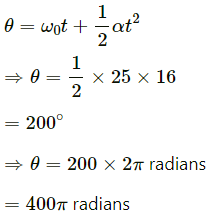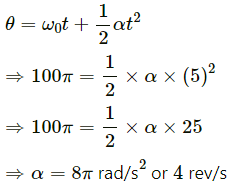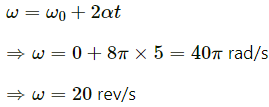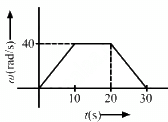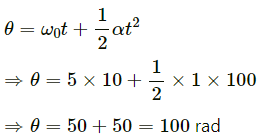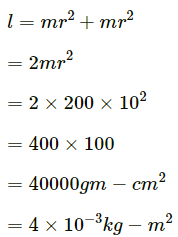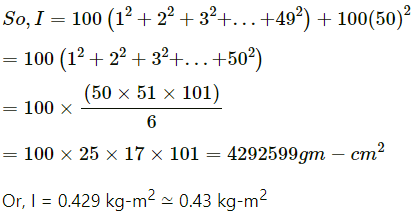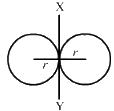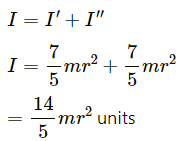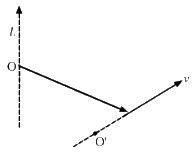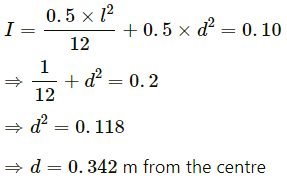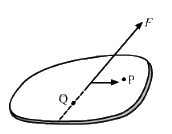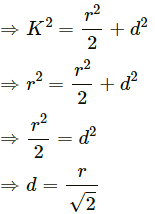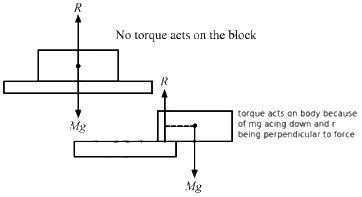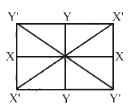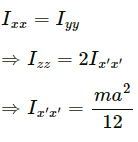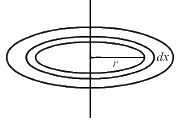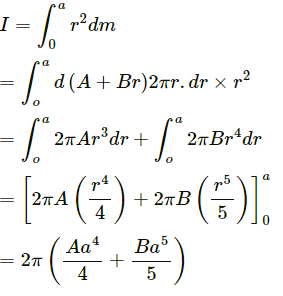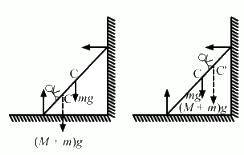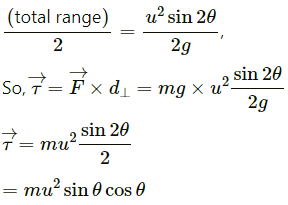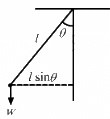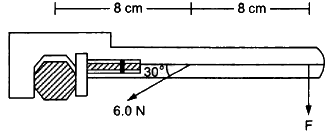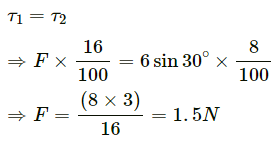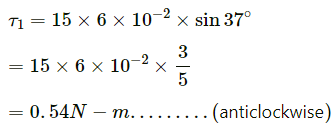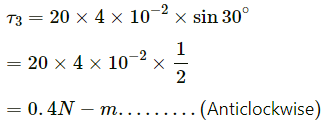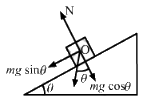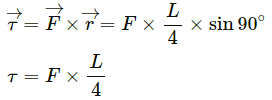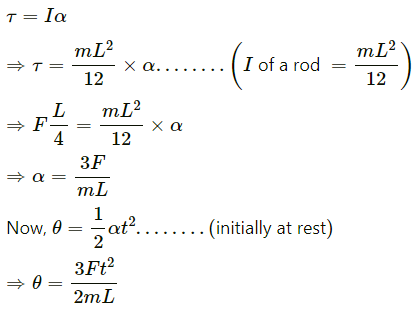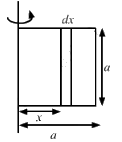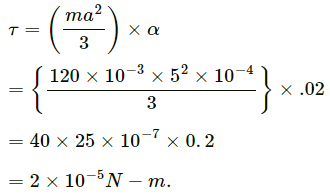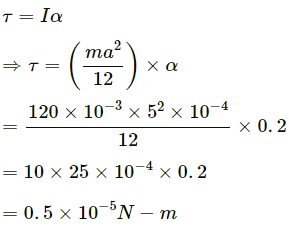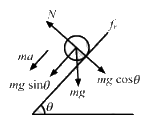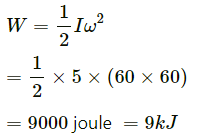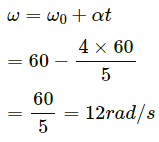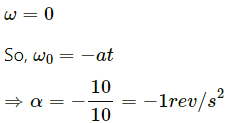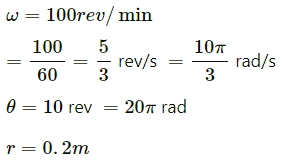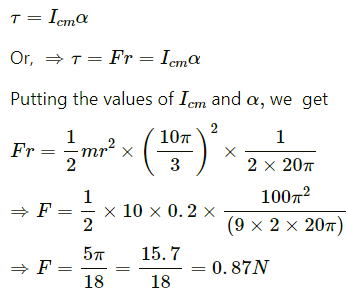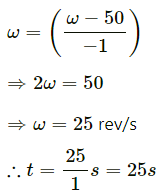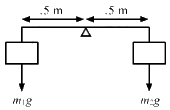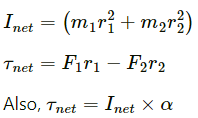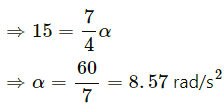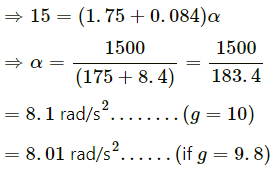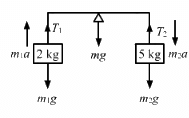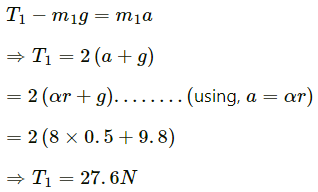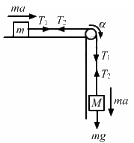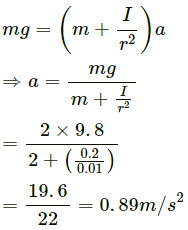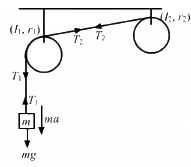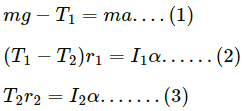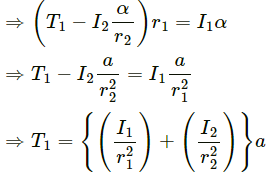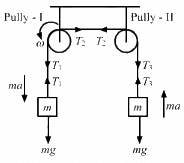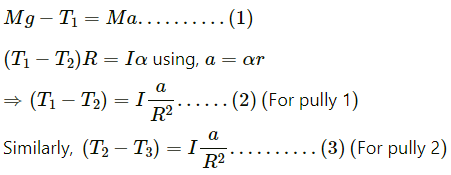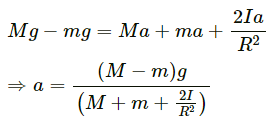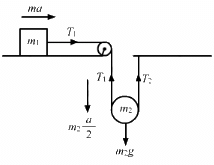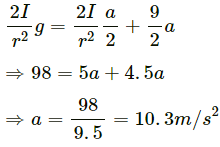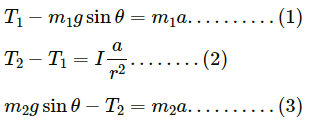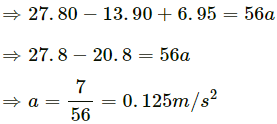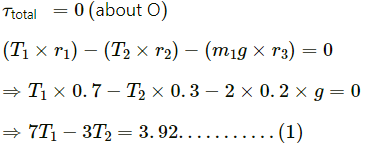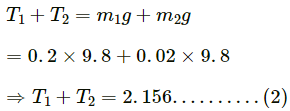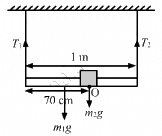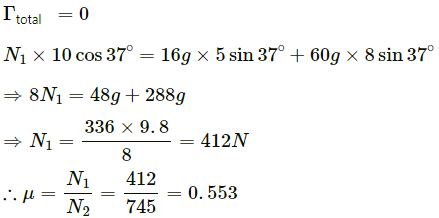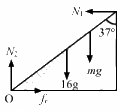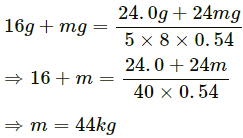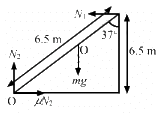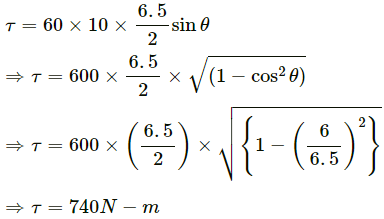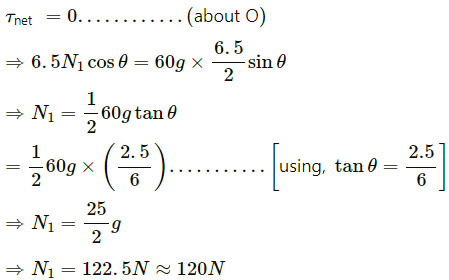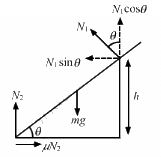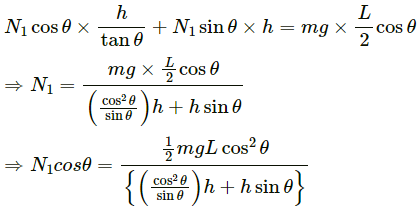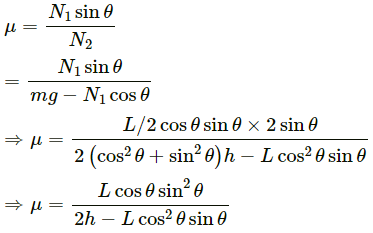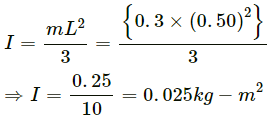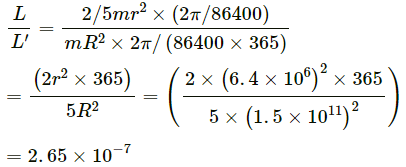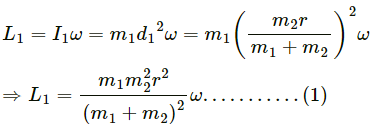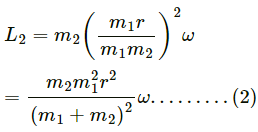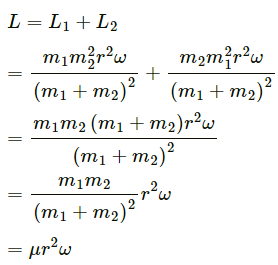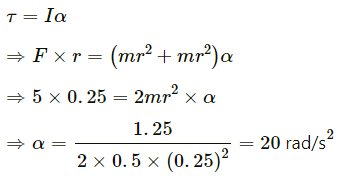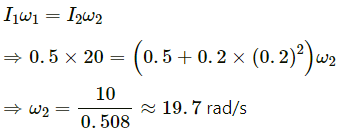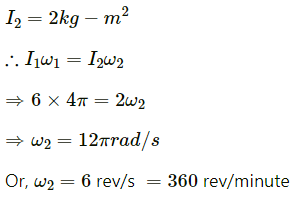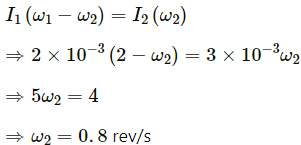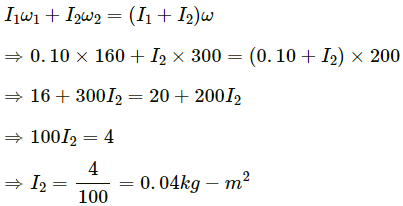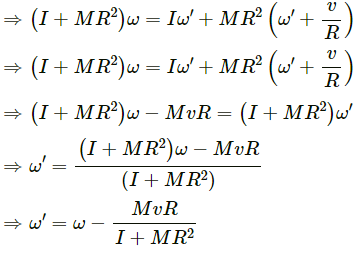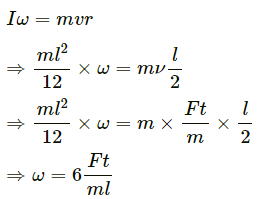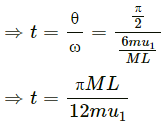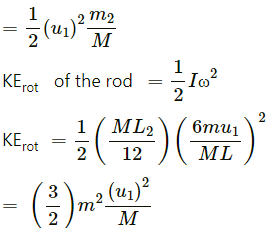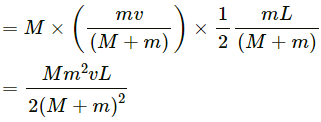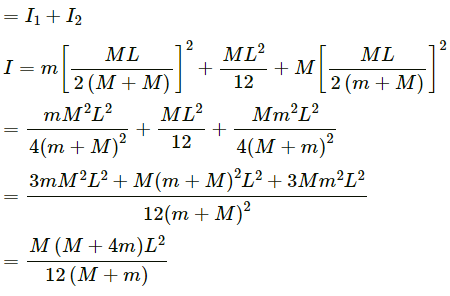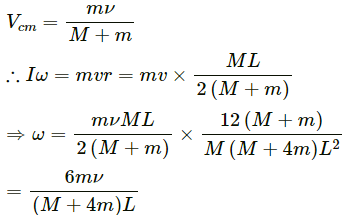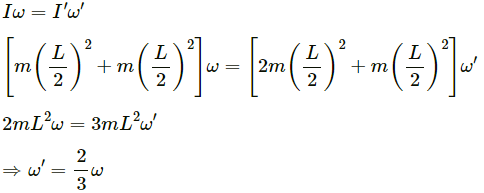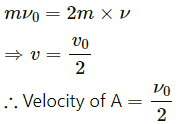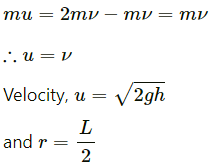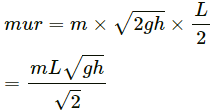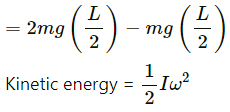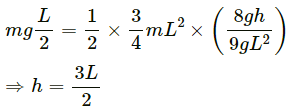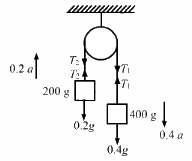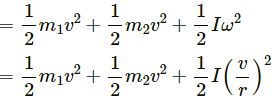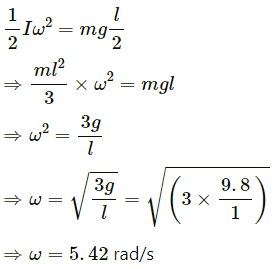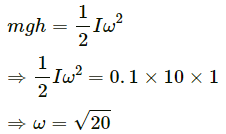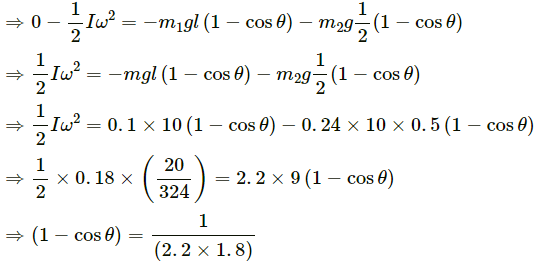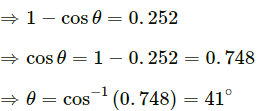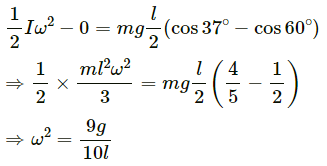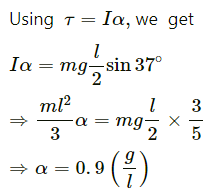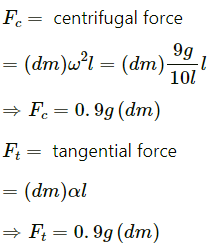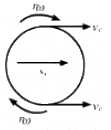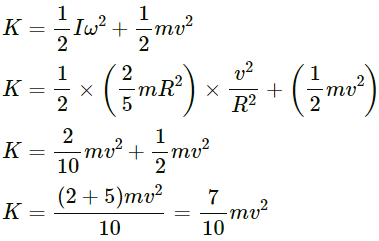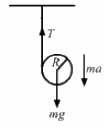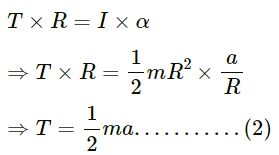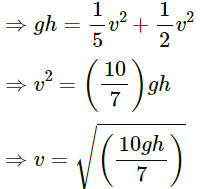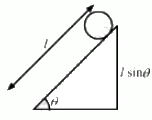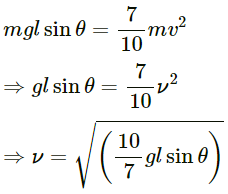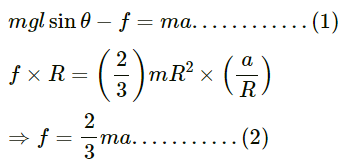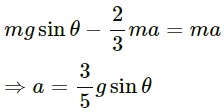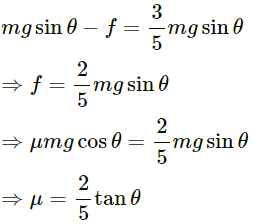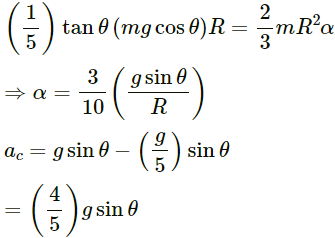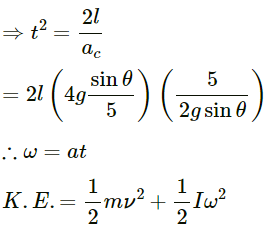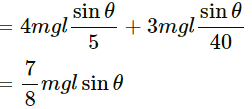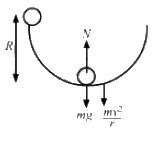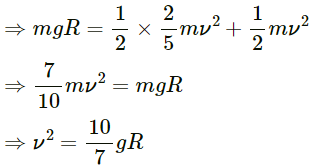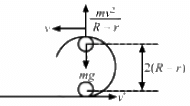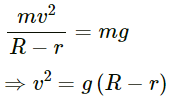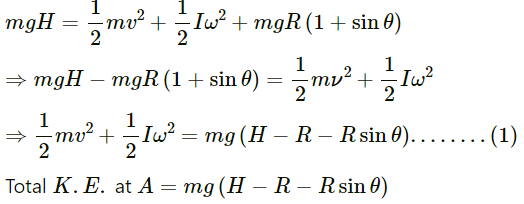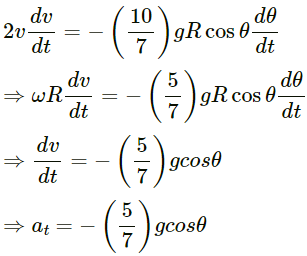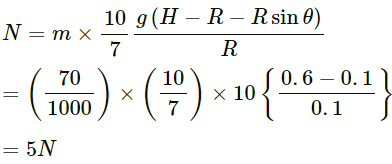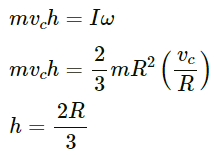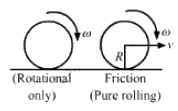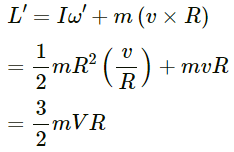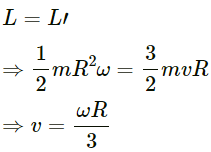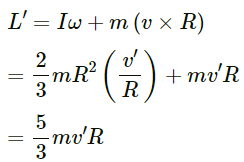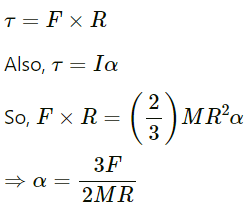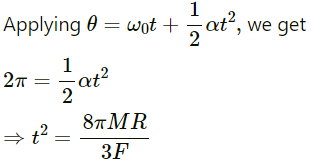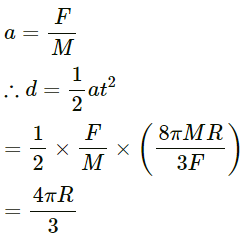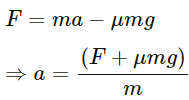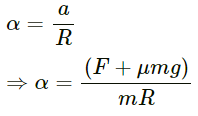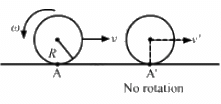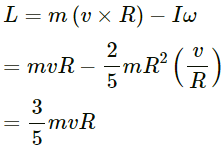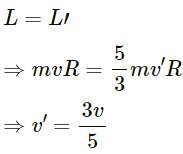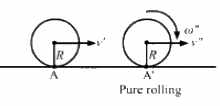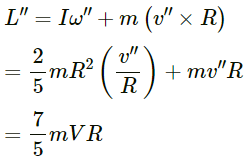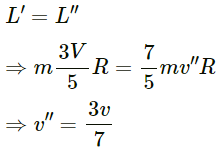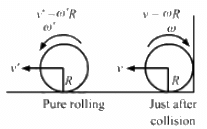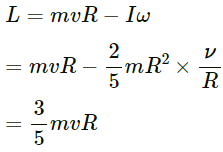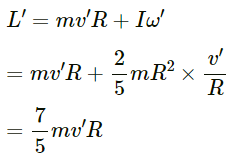HC Verma Questions and Solutions: Chapter 10: Rotational Mechanics- 2 | HC Verma Solutions - JEE PDF Download
Exercise
Q.1. A wheel is making revolutions about its axis with uniform angular acceleration. Starting from rest, it reaches 100 rev/sec in 4 seconds. Find the angular acceleration. Find the angle rotated during these four seconds.
Given
t = 4s
Initial angular velocity = ω0 = 0
Final angular velocity = ω = 100 rev/s
Now, we have
Q.2. A wheel rotating with uniform angular acceleration covers 50 revolutions in the first five seconds after the start. Find the angular acceleration and the angular velocity at the end of five seconds.
Given
Angular displacement of the wheel =
Initial angular velocity of the wheel = ω0 = 0
After, t = 5 seconds
Q.3. A wheel starting from rest is uniformly accelerated at 4 rad/s2 for 10 seconds. It is allowed to rotate uniformly for the next 10 seconds and is finally brought to rest in the next 10 seconds. Find the total angle rotated by the wheel.
It is given that the area under the ω−t curve gives the total angular displacement.
∴ Maximum angular velocity = ω = αt
Area under the curve
= 800 rad
∴ Total angle rotated in 30 s = 800 rad.
Q.4. A body rotates about a fixed axis with an angular acceleration of one radian/second. Through what angle does it rotate during the time in which its angular velocity increases from 5 rad/s to 15 rad/s.
Given
Angular acceleration of the body = α = 2 rad/s2
Initial angular velocity of the body = ω0 = 5rad/s2
Final angular velocity of the body = ω = 15rad/s
We know that:
Also,
Q.5. Find the angular velocity of a body rotating with an acceleration of 2 rev/s2 as it completes the 5th revolution after the start.
Angular displacement of the body,
Initial angular velocity, \omega_0 = 0
Final angular velocity, \omega = ?
Q.6.1. A disc of radius 10 cm is rotating about its axis at an angular speed of 20 rad/s. Find the linear speed of a point on the rim.
Radius of disc = r = 10 cm = 0.1 m
Angular velocity of the disc = ω = 20 rad/s
∴ Linear velocity of point on the rim = v= ωr
⇒ v = 20 x 0.1 = 2 m/s
Q.6.2. A disc of radius 10 cm is rotating about its axis at an angular speed of 20 rad/s. Find the linear speed of the middle point of a radius.
∴ Linear velocity of point at the middle of radius
Q.7. A disc rotates about its axis with a constant angular acceleration of 4 rad/s2. Find the radial and tangential accelerations of a particle at a distance of 1 cm from the axis at the end of the first second after the disc starts rotating.
Angular acceleration of the disc,
α = 4rad/s2
Distance of the particle from the axis of rotation,
So, ω = αt = 4 rad/s ....(t = 1s)
Radial acceleration,
Tangential acceleration,
Q.8. A block hangs from a string wrapped on a disc of radius 20 cm free to rotate about its axis which is fixed in a horizontal position. If the angular speed of the disc is 10 rad/s at some instant, with what speed is the block going down at that instant?
It is given that the string is moving on the rim of the disc and block is connected with the string.
Therefore, the speeds of the block going down and the rim will be same.
Angular speed of the disc, ω = 10 rad/s
Radius of the pulley, r = 20 cm
Linear velocity of the rim, v = Tangential velocity = rω
v = 10 × 20 = 200 cm/s = 2 m/s
Therefore, velocity of the block = 2 m/s
Q.9.1. Three particles, each of mass 200 g, are kept at the corners of an equilateral triangle of side 10 cm. Find the moment of inertial of the system about an axis joining two of the particles.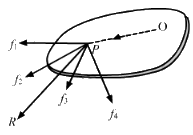
The distance of mass at A from the axis passing through side BC,
Therefore, we have
Moment of inertia of mass about the axis BC,
Q.9.2. Three particles, each of mass 200 g, are kept at the corners of an equilateral triangle of side 10 cm. Find the moment of inertial of the system about an axis passing through one of the particles and perpendicular to the plane of the particles.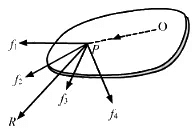
let the axis of rotation passes through A and is perpendicular to the plane of triangle.
Therefore, we have
Net moment of inertia,
Q.10. Particles of masses 1 g, 2 g, 3 g, .........., 100 g are kept at the marks 1 cm, 2 cm, 3 cm, ..........., 100 cm respectively on a metre scale. Find the moment of inertia of the system of particles about a perpendicular bisector of the metre scale.
It is given that the perpendicular bisector of the metre scale is passed through the 50thparticle.
Therefore, on the L.H.S. of the axis, there will be 49 particles and on the R.H.S., there will be 50 particles.
Consider the two particles positioned at 49 cm and 51 cm.
Moment of inertia due to these two particles = 49 × (1)2 + 51 × (1)2
I1 = 100 × 1 = 100 gm-cm2
Similarly, if we consider particles positioned at 48 cm and 52 cm, we get
I2 = 100 × (2)2 gm-cm2
Thus, we will get 49 such sets and one particle at 100 cm. Therefore, total moment of inertia,
Here, I' is the moment of inertia of particle at 100 cm.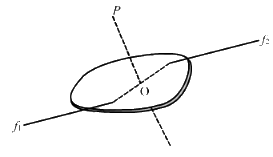
Q.11. Find the moment of inertia of a pair of spheres, each having a mass mass m and radius r, kept in contact about the tangent passing through the point of contact.
It is given that two bodies of mass m and radius r are moving along a common tangent.
Moment of inertia of the first body about XY tangent,
Moment of inertia of the second body about XY tangent,
Therefore, net moment of inertia,
Q.12. The moment of inertia of a uniform rod of mass 0⋅50 kg and length 1 m is 0⋅10 kg-m2 about a line perpendicular to the rod. Find the distance of this line from the middle point of the rod.
Given
Length of the rod, l = 1 m
Mass of the rod, m = 0.5 kg
Let the rod moves at a distance d from the centre.
On applying parallel axis theorem, we get
Moment of inertia about that axis,
Q.13. Find the radius of gyration of circular ring of radius r about a line perpendicular to the plane of the ring and passing through one of its particles.
Moment of inertia of the ring about a point on the rim of the ring and the axis perpendicular to the plane of the ring = mR2 + mR2 = 2mR2 (from parallel axis theorem)
We know that
K = Radius of the gyration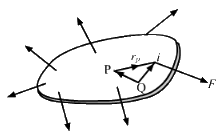
Q.14. The radius of gyration of a uniform disc about a line perpendicular to the disc equals its radius. Find the distance of the line from the centre.
Moment of inertia of the disc about the centre and perpendicular to the plane of the disc = 1/2 mr2
Radius of gyration of the disc about a point = Radius of the disc
Therefore
(k = Radius of gyration about acceleration point; d = Distance of that point from the centre)
Q.15. Find the moment of inertia of a uniform square plate of mass m and edge a about one of its diagonals.
Let there be a small sectional area of width dx at a distance x from the x-axis.
So,
Mass of element
Moment of inertia about x-axis,
Similarly,
Now,(Pendicular axis theorem)
The two diagonals are perpendicular to each other; therefore, we have
Also,
Q.16. The surface density (mass/area) of a circular disc of radius a depends on the distance from the centre as [rholeft( r right) = A + Br.] Find its moment of inertia about the line perpendicular to the plane of the disc thorough its centre.
Consider a ring of thickness dx at a distance r from the centre of the disc.
Mass of the ring,
Therefore, moment of inertia about the centre,
Q.17. A particle of mass m is projected with a speed u at an angle θ with the horizontal. Find the torque of the weight of the particle about the point of projection when the particle is at the highest point.
Range of the particle
At the highest point, we have
Total force acting on the particle = mg (downward)
Distance between the line of force and the point of projection
Therefore, the direction of torque is perpendicular to the plane of the motion.
Q.18. A simple pendulum of length l is pulled aside to make an angle θ with the vertical. Find the magnitude of the torque of the weight ω of the bob about the point of suspension. When is the torque zero?
Distance between the line of force and point of suspension,
Here, w is the weight of the bob.
The torque will be zero when the force acting on the body passes through the point of suspension, i.e., at the lowest point of suspension.
Q.19. When a force of 6⋅0 N is exerted at 30° to a wrench at a distance of 8 cm from the nut it is just able to loosen the nut. What force F would be sufficient to loosen it if it acts perpendicularly to the wrench at 16 cm from the nut?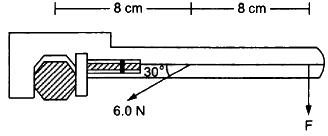
In the first case,
In first case,
To loosen the nut, torque in both the cases should be the same.
Thus, we have
Q.20. Calculate the total torque acting on the body shown in the following figure about the point O.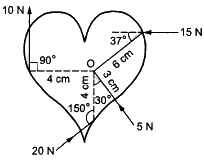
Torque about a point = Total force × Perpendicular distance
Let the anticlockwise torque and clockwise acting torque be positive and negative, respectively.
Torque at O due to 5 N force is zero as it is passing through O.
Torque at O due to 15 N force,
Torque at O due to 10 N force,
Torque at O due to 20 N force,
Resultant torque acting at O,
Q.21. A cubical block of mass m and edge a slides down a rough inclined plane of inclination θ with a uniform speed. Find the torque of the normal force acting on the block about its centre.
Let N be the normal reaction on the block.
From the free body diagram of the block, it is clear that forces N and mgcosθ pass through the same line. So, there will be no torque due to N and mg cosθ. The only torque will be produced by mg sinθ.
a is the edge of the cube. Therefore, we have
Q.22. A rod of mass m and length L, lying horizontally, is free to rotate about a vertical axis through its centre. A horizontal force of constant magnitude F acts on the rod at a distance of L/4 from the centre. The force is always perpendicular to the rod. Find the angle rotated by the rod during the time t after the motion starts.
Torque about the centre due to force,
Let the torque produces an angular acceleration α.
Q.23. A square plate of mass 120 g and edge 5⋅0 cm rotates about one of the edges. If it has a uniform angular acceleration of 0⋅2 rad/s2 what torque acts on the plate?
Consider a small area element of width dx and length a at a distance x from the axis of rotation.
Mass of element, dm(m = mass of the square, a = side of the plate)
Now, torque produced,
Q.24. Calculate the torque on the square plate of the previous problem if it rotates about a diagonal with the same angular acceleration.
Moment of inertia of a square plate about its diagonals,
Therefore, we have
Torque produced,
Q.25. A flywheel of moment of inertia 5⋅0 kg-m2 is rotated at a speed of 60 rad/s. Because of the friction at the axle it comes to rest in 5⋅0 minutes. Find (a) the average torque of the friction (b) the total work done by the friction and (c) the angular momentum of the wheel 1 minute before it stops rotating.
Let the angular deceleration produced due to frictional force be α.
Initial angular acceleration,
Final angular velocity,
ω = 0
t = 5 min =300 s
We know that
(a) Torque produced by the frictional force (R),
\[\tau = I\alpha = 5 \times $\left( \frac{- 1}{5}
right)\]
= 1 N - m opposite to the rotation of wheel
(b) By conservation of energy,
Total work done in stopping the wheel by frictional force = Change in energy
(c) Angular velocity after 4 minutes,
So, angular momentum about the centre,
Q.26. Because of the friction between the water in oceans with the earth's surface the rotational kinetic energy of the earth is continuously decreasing. If the earth's angular speed decreases by 0⋅0016 rad/day in 100 years find the average torque of the friction on the earth. Radius of the earth is 6400 km and its mass is 6⋅0 × 1024 kg.
Rate of change of angular velocity, i.e., angular acceleration,

Torque produced by the ocean water in decreasing the Earth's angular velocity,
Q.27. A wheel rotating at a speed of 600 rpm (revolutions per minute) about its axis is brought to rest by applying a constant torque for 10 seconds. Find the angular deceleration and the angular velocity 5 seconds after the application of the torque.
Initial angular velocity of the wheel,
ω0 = 600rpm
= 600/60 = 10 revolutions per second
After 10 seconds,
Final angular velocity of the wheel,
Now, t = 5s
We know that
Q.28. A wheel of mass 10 kg and radius 20 cm is rotating at an angular speed of 100 rev/min when the motor is turned off. Neglecting the friction at the axle, calculate the force that must be applied tangentially to the wheel to bring it to rest in 10 revolutions.
Initial angular velocity of the wheel,
Angular deceleration produced by the tangential force in order to stop the wheel after 10 revolutions,
Torque by which the wheel will come to rest,
Q.29. A cylinder rotating at an angular speed of 50 rev/s is brought in contact with an identical stationary cylinder. Because of the kinetic friction, torques act on the two cylinders accelerating the stationary one and decelerating the moving one. If the common magnitude of the acceleration and deceleration be one revolution per second square, how long will it take before the two cylinders have equal angular speed?
After t seconds, let the angular velocity of two cylinders be ω.
For the first cylinder,
For the second cylinder,
On equating the value of t, we get
Q.30. A body rotating at 20 rad/s is acted upon by a constant torque providing it a deceleration of 2 rad/s2. At what time will the body have kinetic energy same as the initial value if the torque continues to act?
Given
Initial angular acceleration, ω0 = 20 rad/s
Angular deceleration,
So, in 10 s the body will come to rest.
The same torque continues to act on the body, therefore, it will produce the same angular acceleration.
The kinetic energy of the body is same as the initial value; therefore, its angular velocity should be equal to the initial value ω0.
Therefore, time required to come to that angular velocity,
So, total time required,
t = t1 + t2 = 20s
Q.31. A light rod of length 1 m is pivoted at its centre and two masses of 5 kg and 2 kg are hung from the ends as shown in the following figure. Find the initial angular acceleration of the rod assuming that it was horizontal in the beginning.
Total moment of inertia of the system about the axis of rotation,
On equating the value of τnet and putting the value of lnet, we get
Q.32. Suppose the rod in the previous problem has a mass of 1 kg distributed uniformly over its length
(a) Find the initial angular acceleration of the rod.
(b) Find the tension in the supports to the blocks of mass 2 kg and 5 kg.
Total moment of inertia of the system about the axis of rotation,
m and l are the mass and length of the rod, respectively.
On equating the value of τnet and putting the value of lnet, we get
(b) From the free body diagram of the block of mass 2 kg,
From the free body diagram of the block of mass 5 kg,
Q.33. The following figure shows two blocks of mass m and M connected by a string passing over a pulley. The horizontal table over which the mass m slides is smooth. The pulley has a radius r and moment of inertia I about its axis and it can freely rotate about this axis. Find the acceleration of the mass M assuming that the string does not slip on the pulley.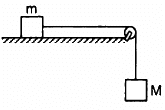
According to the equation, we have
If we add the equations (1) and (2), we get
Q.34. A string is wrapped on a wheel of moment of inertia 0⋅20 kg-m2 and radius 10 cm and goes through a light pulley to support a block of mass 2⋅0 kg as shown in the following figure. Find the acceleration of the block.
Moment of inertia of the bigger pulley, I = 0.20 kg-m2
r = 10 cm = 0.1 m,
Smaller pulley is light. Therefore, on neglecting its moment of inertia, we have
Mass of the block, m = 2 kg
From the free body diagram, we get
Using equations (1) and (2), we get
Q.35. Suppose the smaller pulley of the previous problem has its radius 5⋅0 cm and moment of inertia 0⋅10 kg-m2. Find the tension in the part of the string joining the pulleys.
Given
m = 2 kg, I1 = 0.10 kg-m2
r1 = 5 cm = 0.05 m
I2 = 2.20 kg-m2
r2 = 10 cm = 0.1 m
From the free body diagram, we have
Substituting the value of T2 in the equation (2), we get
Substituting the value of T1 in the equation (1), we get
Q.36. The pulleys shown in the following figure are identical, each having a radius R and moment of inertia I. Find the acceleration of the block M.
Free the body diagram of the system,
For block of mass M,
For block of mass m,
Adding equations (2) and (3), we get
Adding equations (1) and (4), we get
Using equations (5) and (6), we get
Q.37. The descending pulley shown in the following figure has a radius 20 cm and moment of inertia 0⋅20 kg-m2. The fixed pulley is light and the horizontal plane frictionless. Find the acceleration of the block if its mass is 1⋅0 kg.
Let the mass of block be m1 and mass of pulley be m2.
Acceleration of the massive pulley will be half of that of the block.
From the free body diagram, we have
Putting the value of mass in equation (1) and using equation (1) in equation (2), we get
On replacing the value of
Q.38. The pulley shown in the following figure has a radius 10 cm and moment of inertia 0⋅5 kg-m2 about its axis. Assuming the inclined planes to be frictionless, calculate the acceleration of the 4⋅0 kg block.
From the figure, we have
Adding equations (1) and (3), we get
Q.39. Solve the previous problem if the friction coefficient between the 2⋅0 kg block and the plane below it is 0⋅5 and the plane below the 4⋅0 kg block is frictionless.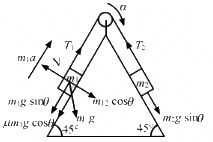
From the figure, we have
Adding equations (1) and (2), we get
Q.40. A uniform metre stick of mass 200 g is suspended from the ceiling thorough two vertical strings of equal lengths fixed at the ends. A small object of mass 20 g is placed on the stick at a distance of 70 cm from the left end. Find the tensions in the two strings.
Given
Mass of the stick
m1 = 200g
Mass of the small object = m2 = 20
Length of the string = l = 1m
As the system is in equilibrium, we have
Now, we have
Total upward force = Total downward force
Solving equations (1) and (2), we get
Q.41. A uniform ladder of length 10⋅0 m and mass 16⋅0 kg is resting against a vertical wall making an angle of 37° with it. The vertical wall is frictionless but the ground is rough. An electrician weighing 60⋅0 kg climbs up the ladder. If he stays on the ladder at a point 8⋅00 m from the lower end, what will be the normal force and the force of friction on the ladder by the ground? What should be the minimum coefficient of friction for the electrician to work safely?
Let N2 be the normal force on the ladder by the ground.
Let N1 be the normal force on the ladder by the wall.
Let fr be the force of friction on the ladder by the ground.
As system is in translation equilibrium, we have
Applying condition of rotational equilibrium at point O,
i.e., about point O, we have
Q.42. Suppose the friction coefficient between the ground and the ladder of the previous problem is 0.540. Find the maximum weight of a mechanic who could go up and do the work from the same position of the ladder.
Let the maximum mass of a mechanic who could go up be m.
The system is in translation and rotational equilibrium; therefore, we have
From eq. (2), we have
Putting the value of N2 in eq.(1), we have
Therefore, weight of the mechanic, who can go up and do the work, should be less than 44 kg.
Q.43. A 6⋅5 m long ladder rests against a vertical wall reaching a height of 6⋅0 m. A 60 kg man stands half way up the ladder. (a) Find the torque of the force exerted by the man on the ladder about the upper end of the ladder. (b) Assuming the weight of the ladder to be negligible as compared to the man and assuming the wall to be smooth, find the force exerted by the ground on the ladder.
Given
Mass of the man = m = 60 kg
Ladder length = 6.5 m
Height of the wall = 6 m
(a) We have to find the torque due to the weight of the body about the upper end of the ladder.
(b) Let us find the vertical force exerted by the ground on the ladder.
Vertical force exerted by the ground on the ladder = μR2 = R1
As system is in rotational equilibrium, we have
Q.44. The door of an almirah is 6 ft high, 1⋅5 ft wide and weighs 8 kg. The door is supported by two hinges situated at a distance of 1 ft from the ends. If the magnitudes of the forces exerted by the hinges on the door are equal, find this magnitude.
It is given that the magnitudes of the forces exerted by the hinges on the door are equal.
Therefore, we have
Resultant of N1 and F1 at point A = Resultant of N2 and F2 at point B
System is in translation equilibrium. Therefore, we have
Putting the value in eq. (1), we get
F1 = F2
Let us take the torque about point B. We get
Now, the forces exerted by the hinges A on the door,
Q.45. A uniform rod of length L rests against a smooth roller as shown in the following figure. Find the friction coefficient between the ground and the lower end if the minimum angle that the rod can make the horizontal is θ.
Given
Length of rod = L
It makes an angle θ with the floor.
Height of the wall is h.
The system is in translational equilibrium; therefore, we get
System is in rotational equilibrium; therefore, we have
From equation (2), we have
Q.46. A uniform rod of mass 300 g and length 50 cm rotates at a uniform angular speed of 2 rad/s about an axis perpendicular to the rod through an end. Calculate (a) the angular momentum of the rod about the axis of rotation, (b) the speed of the centre of the rod and (c) its kinetic energy.
Given
Mass of the rod = m = 300 gm
Length of the rod = l = 50 cm
Angular velocity of the rod = ω = 2 rad/s
(a) Moment of inertia about one end of the rod,
Angular momentum about that point,
L = Iω
L = 0.025 × 2 = 0.05 kg-m2/s
(b) Speed of the centre of the rod,
(c) Kinetic energy,
Q.47. A uniform square plate of mass 2⋅0 kg and edge 10 cm rotates about one of its diagonals under the action of a constant torque of 0⋅10 N-m. Calculate the angular momentum and the kinetic energy of the plate at the end of the fifth second after the start.
Given
Torque acting on the plate = τ = 0.10N-m
Mass of the plate = m = 2kg
On applying τ = Iα, we get
Let ω be the angular velocity after time t (t = 5 s).
Therefore, we have
Angular momentum,
Kinetic energy,
Q.48. Calculate the ratio of the angular momentum of the earth about its axis due to its spinning motion to that about the sun due to its orbital motion. Radius of the earth = 6400 km and radius of the orbit of the earth about the sun = 1⋅5 × 108 km.
Given
r = 6400 km = 6.4 × 106 m;
R = 1⋅5 × 108 km = 1⋅5 × 1011 m
About its axis, we have
T = 1 day = 86400 s;
Angular momentum of the Earth about its axis,
About the Sun's axis,
T = 365 day = 365 × 86400 s
Angular momentum of the Earth about the Sun's axis,
Ratio of angular momentums,
Q.49. Two particles of masses m1 and m2 are joined by a light rigid rod of length r. The system rotates at an angular speed ω about an axis through the centre of mass of the system and perpendicular to the rod. Show that the angular momentum of the system is L = μr2ω where μ is the reduced mass of the system defined as 
Distance of centre of mass from mass m1,
Angular momentum due to the mass m1 at the centre of system,
Similarly, the angular momentum due to the mass m2 at the centre of system,
Therefore, net angular momentum,
Q.50. A dumb-bell consists of two identical small balls of mass 1/2 kg each connected to the two ends of a 50 cm long light rod. The dumb-bell is rotating about a fixed axis thorough the centre of the rod and perpendicular to it at an angular speed of 10 rad/s. An impulsive force of average magnitude 5⋅0 N acts on one of the masses in the direction of its velocity for 0⋅10 s. Find the new angular velocity of the system.
Moment of inertia of the dumb-bell,
I = mr2 + mr2 = 2mr2
Torque,
Given
Using ω = ω0 + αt, we get
Q.51. A wheel of moment of inertia 0⋅500 kg-m2 and radius 20⋅0 cm is rotating about its axis at an angular speed of 20⋅0 rad/s. It picks up a stationary particle of mass 200 g at its edge. Find the new angular speed of the wheel.
Given
Initial moment of inertia of the system,
I1 = 0.500 kg-m2;
r = 0.2 m;
ω = 20 rad/s
Mass of the stationary particle, m = 0.2 kg
Final moment of inertia of the system,
I2 = I1 + mr2
It is given
External torque = 0
Angular momentum is conserved; therefore, we have
Q.52. A diver having a moment of inertia of 6⋅0 kg-m2 about an axis thorough its centre of mass rotates at an angular speed of 2 rad/s about this axis. If he folds his hands and feet to decrease the moment of inertia to 5⋅0 kg-m2, what will be the new angular speed?
Initial moment of inertia of diver, I1 = 6 kg-m2
Initial angular velocity of diver, ω1 = 2 rad/s
Final moment of inertia of diver, I2 = 5 kg-m2
Let ω2 be the final angular velocity of the diver.
We have
External torque = 0
∴ I1ω1 = I2ω2
Q.53. A boy is seated in a revolving chair revolving at an angular speed of 120 revolutions per minute. Two heavy balls form part of the revolving system and the boy can pull the balls closer to himself or may push them apart. If by pulling the balls closer, the boy decreases the moment of inertia of the system from 6 kg-m2 to 2 kg-m2, what will be the new angular speed?
Given
Initial angular speed of the system,
Initial moment of inertia of the system,
Final moment of inertia of the system,
Two balls are inside the system; therefore, we get
Total external torque = 0
Q.54. A boy is standing on a platform which is free to rotate about its axis. The boy holds an open umbrella in his hands. The axis of the umbrella coincides with that of the platform. The moment of inertia of "the platform plus the boy system" is 3⋅0 × 10−3 kg-m2 and that of the umbrella is 2⋅0 × 10−3 kg-m2. The boy starts spinning the umbrella about the axis at an angular speed of 2⋅0 rev/s with respect to himself. Find the angular velocity imparted to the platform.
Given
Moment of inertia of umbrella = I1 = 2 × 10−3 kg-m2
Moment of inertia of the system = I2 = 3 × 10−3 kg-m2
Angular speed of the umbrella with respect to the boy = ω1 = 2 rev/s
Let the angular velocity imparted to the platform be ω2.
Taking the Earth as the reference, we have
Angular velocity of the umbrella = (ω1 − ω2)
Applying conservation of angular momentum, we get
Q.55. A wheel of moment of inertia 0⋅10 kg-m2 is rotating about a shaft at an angular speed of 160 rev/minute. A second wheel is set into rotation at 300 rev/minute and is coupled to the same shaft so that both the wheels finally rotate with a common angular speed of 200 rev/minute. Find the moment of inertia of the second wheel.
Given
For the first wheel,
I1 = 10 kg-m2 and ω1 = 160 rev/min
For the second wheel, ω2 = 300 rev/min
Let I2 be the moment of inertia of the second wheel.
After they are coupled, we have
ω = 200 rev/min
If we take the two wheels to be an isolated system, we get
Total external torque = 0
Therefore, we have
Q.56. A kid of mass M stands at the edge of a platform of radius R which can be freely rotated about its axis. The moment of inertia of the platform is I. The system is at rest when a friend throws a ball of mass m and the kid catches it. If the velocity of the ball is v horizontally along the tangent to the edge of the platform when it was caught by the kid, find the angular speed of the platform after the event.
On considering two bodies as a system, we get
Moment of inertia of kid and ball about the axis
Applying the law of conservation of angular momentum, we have
Q.57. Suppose the platform of the previous problem is brought to rest with the ball in the hand of the kid standing on the rim. The kid throws the ball horizontally to his friend in a direction tangential to the rim with a speed v as seen by his friend. Find the angular velocity with which the platform will start rotating.
Initial angular momentum of the system is zero (L1 = 0)
Let the platform starts rotating with an angular velocity ω.
Therefore, we have
Final angular momentum of the system = L2
(m = mass of the ball, v = velocity of the ball)
Total external torque = 0
Also,
Initial angular momentum = Final angular momentum
Q.58. Suppose the platform with the kid in the previous problem is rotating in anticlockwise direction at an angular speed ω. The kid starts walking along the rim with a speed v relative to the platform also in the anticlockwise direction. Find the new angular speed of the platform.
Let ω' be the angular velocity of platform after the kid starts walking.
Let ω be the angular velocity of the wheel before walking.
When we see the (kid-wheel) system from the initial frame of reference, we can find that the wheel moves with a speed of ω and the kid with a speed ofafter the kid has started walking.
Initial angular momentum of the system = (I + MR2)ω
Angular velocity of the kid after it starts walking =
External torque is zero; therefore, angular momentum is conserved.
Q.59. A uniform rod of mass m and length l is struck at an end by a force F perpendicular to the rod for a short time interval t. Calculate (a) the speed of the centre of mass, (b) the angular speed of the rod about the centre of mass, (c) the kinetic energy of the rod and (d) the angular momentum of the rod about the centre of mass after the force has stopped to act. Assume that t is so small that the rod does not appreciably change its direction while the force acts.
Given
Mass of the rod = m
Length of the rod = l
(a) For the centre of mass,
Acceleration,
a = F/m
Velocity, v = at
(b) Let the angular speed about the centre of mass be ω.
Moment of inertia of rod about centre of mass =
(c) Kinetic energy,
(d) Angular momentum about the centre of mass,
Q.60. A uniform rod of length L lies on a smooth horizontal table. A particle moving on the table strikes the rod perpendicularly at an end and stops. Find the distance travelled by the centre of the rod by the time it turns through a right angle. Show that if the mass of the rod is four times that of the particle, the collision is elastic.
Let initial velocity of the particle = u1
Let final velocity of the particle = v1
Let time taken to move (π/2) angle = t
Given v1 = 0
Let initial velocity of CM of the rod = u2
Given u2 = 0
Let final velocity of the CM of rod = v2
By conservation of linear momentum
mu1 + Mu2 = mv1 + Mv2...(1)
Now by we consider the angular momentum imparted by the particle to the rod.
For rod about its CM,
mu1(L/2) = ωML2/12
Now we know
ω = θ/t
θ = π/2
Linear distance moved by the CM of the rod will be
s = v2t
By equation 1.
Initial KE of the particle is ½m(u1)2
KE of the CM of the rod =...[by equation 1]
To be elastic collision KE must be conserved
Hence Proved.
Q.61. Suppose the particle of the previous problem has a mass m and a speed v before the collision and it sticks to the rod after the collision. The rod has a mass M. (a) Find the velocity of the centre of mass C of the system constituting "the rod plus the particle". (b) Find the velocity of the particle with respect to C before the collision. (c) Find the velocity of the rod with respect to C before the collision. (d) Find the angular momentum of the particle and of the rod about the centre of mass C before the collision. (e) Find the moment of inertia of the system about the vertical axis through the centre of mass C after the collision. (f) Find the velocity of the centre of mass C and the angular velocity of the system about the centre of mass after the collision.
(a) It is given that no external torque and force is applied on the system.
Applying the law of conservation of momentum, we get
(b) Velocity of the particle w.r.t. centre of mass (COM) C before the collision = vc = v - v'
(c) Velocity of the particle w.r.t. COM C before collision =
(d) Distance of the COM from the particle,
∴ Angular momentum of body about COM
∴ Angular momentum of rod about COM
(e) Moment of inertia about COM = I
(f) About COM,
Q.62. Two small balls A and B, each of mass m, are joined rigidly by a light horizontal rod of length L. The rod is clamped at the centre in such a way that it can rotate freely about a vertical axis through its centre. The system is rotated with an angular speed ω about the axis. A particle P of mass m kept at rest sticks to the ball A as the ball collides with it. Find the new angular speed of the rod.
Let the new angular speed of the rod be ω'.
Here, net torque on the system is zero.
So, the angular momentum is conserved.
Therefore, we get
Q.63. Two small balls A and B, each of mass m, are joined rigidly to the ends of a light rod of length L (see the following figure). The system translates on a frictionless horizontal surface with a velocity v0 in a direction perpendicular to the rod. A particle P of mass m kept at rest on the surface sticks to the ball A as the ball collides with it. Find
(a) the linear speeds of the balls A and B after the collision, (b) the velocity of the centre of mass C of the system A + B + P and (c) the angular speed of the system about C after the collision.
[Hint : The light rod will exert a force on the ball B only along its length.]
(a) Collision will not affect the velocity of ball B because the light rod will exert a force on it only along its length.
Therefore, we have
Velocity of B = v0
For ball A,
On applying the law of conservation of linear momentum, we get
(b) If we consider the three bodies to be a system, we have
Net external force = 0
(Direction will be same as the initial velocity before collision.)
(c) Velocity of (A + P) w.r.t. the centre of mass
Velocity of B w.r.t. the centre of mass
Distance of the (A + P) from the centre of mass = l/m
Distance of the B from the centre of mass = 2l/3
Q.64. Suppose the rod with the balls A and B of the previous problem is clamped at the centre in such a way that it can rotate freely about a horizontal axis through the clamp. The system is kept at rest in the horizontal position. A particle P of the same mass m is dropped from a height h on the ball B. The particle collides with B and sticks to it. (a) Find the angular momentum and the angular speed of the system just after the collision. (b) What should be the minimum value of h so that the system makes a full rotation after the collision.
(a) Angular momentum = mvr
Let the particle P collides the ball B with a speed u and system moves with speed v just after the collision.
Applying the law of conservation of linear momentum, we get
Initial angular momentum of system about COM of rod,Angular momentum of system about COM of the rod just after the collision = lω
Applying the law of conservation of angular momentum and obtaining the value of ω, we get
(b) When the mass 2m and m are at the top most position and at the lowest point, respectively, they will automatically rotate. In this position, we have
Total gain in potential energy
Therefore, by the law of conservation of energy, we have
Q.65. Two blocks of masses 400 g and 200 g are connected through a light string going over a pulley which is free to rotate about its axis. The pulley has a moment of inertia 1.6 x 10-4kg-m2 and a radius 2⋅0 cm, Find (a) the kinetic energy of the system as the 400 g block falls through 50 cm, (b) the speed of the blocks at this instant.
From the free body diagram, we have
On solving the above equations, we get
On solving the (b) part of the question first, we have
Speed of the blocks =
(a) Total kinetic energy of the system
Q.66. The pulley shown in the following figure has a radius of 20 cm and moment of inertia 0⋅2 kg-m2. The string going over it is attached at one end to a vertical spring of spring constant 50 N/m fixed from below, and supports a 1 kg mass at the other end. The system is released from rest with the spring at its natural length. Find the speed of the block when it has descended through 10 cm. Take g = 10 m/s2.
Given
Moment of inertia of the pully = I = 0.2 kg-m2
Radius of the pully = r = 0.2 m
Spring constant of the spring = k = 50 N/m
Mass of the block = m = 1 kg
g = 10 ms2 and h = 0.1 m
On applying the law of conservation of energy, we get
On putting x = h = 0.1 m, we get
Q.67. A metre stick is held vertically with one end on a rough horizontal floor. It is gently allowed to fall on the floor. Assuming that the end at the floor does not slip, find the angular speed of the rod when it hits the floor.
Let the mass of the rod and its angular velocity be m and ω (when hits the ground), respectively.
It is given that the rod has rotational motion only.
On applying the law of conservation of energy, we get
Q.68. A metre stick weighing 240 g is pivoted at its upper end in such a way that it can freely rotate in a vertical place through this end (see the following figure). A particle of mass 100 g is attached to the upper end of the stick through a light string of length 1 m. Initially, the rod is kept vertical and the string horizontal when the system is released from rest. The particle collides with the lower end of the stick and sticks there. Find the maximum angle through which the stick will rise.
Let the angular velocity of stick after the collision be ω.
Given
Mass of the stick = m = 240 g
Mass of the particle = m' = 100 g
Length of the string (or rod) = r = l = 1 m
Moment of inertia of the particle about the pivoted end = I' = m'r2
Moment of inertia of the rod about the pivoted end
Applying the law of conservation of energy, we get
Final energy of the particle = Initial energy of the rod
For collision, we have
Q.69. A uniform rod pivoted at its upper end hangs vertically. It is displaced through an angle of 60° and then released. Find the magnitude of the force acting on a particle of mass dm at the tip of the rod when the rod makes an angle of 37° with the vertical.
Let the length of the rod be l.
Mass of the rod be m.
Let the angular velocity of the rod be ω when it makes an angle of 37° with the vertical.
On applying the law of conservation of energy, we get
Let the angular acceleration of the rod be α when it makes an angle of 37° with the vertical.
Force on the particle of mass dm at the tip of the rod
So, total force on the particle of mass dm at the tip of the rod will be the resultant of Fc and Ft.
Q.70. A cylinder rolls on a horizontal place surface. If the speed of the centre is 25 m/s, what is the speed of the highest point?
Let vc be the translational velocity of the cylinder.
Let ω be the rotational velocity of the cylinder.
Let r be the radius of the cylinder.
For rolling, we have
vc = rω
Speed of the highest point = vc + rω = 2vc
Q.71. A sphere of mass m rolls on a plane surface. Find its kinetic energy at an instant when its centre moves with speed v.
Let radius of the sphere be R and its angular speed be ω.
Moment of inertia of sphere,
Total kinetic energy,
Q.72. A string is wrapped over the edge of a uniform disc and the free end is fixed with the ceiling. The disc moves down, unwinding the string. Find the downward acceleration of the disc.
Let the radius of the disc be R.
Let the tension in the string be T.
Let the acceleration of the disc be a.From the free body diagram, we have
Torque about the centre of disc,
Putting this value in equation (1), we get
Q.73. A small spherical ball is released from a point at a height h on a rough track shown in the following figure. Assuming that it does not slip anywhere, find its linear speed when it rolls on the horizontal part of the track.
Let r be the radius of the ball.
Let v be the linear speed of the ball when it rolls on the horizontal part of the track.
Let ω be the angular speed of the ball when it rolls on the horizontal part of the track.
Potential energy the ball has gained w.r.t. the surface will be converted to angular kinetic energy about the centre and linear kinetic energy.
Therefore, we have
Q.74. A small disc is set rolling with a speed v on the horizontal part of the track of the previous problem from right to left. To what height will it climb up the curved part?
Let the radius of the disc be R.
Let the angular velocity of the disc ω.
Let the height attained by the disc be h.
On applying the law of conservation of energy, we get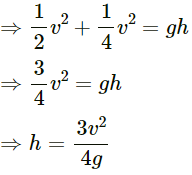
Q.75. A sphere starts rolling down an incline of inclination θ. Find the speed of its centre when it has covered a distance l.
Let radius of the sphere be r. Let r be negligible w.r.t. l.
Potential energy of the sphere, P.E. = mgl sinθ
Total kinetic energy of the sphere of mass m rolling with speed v = (7/10)mv2
On applying the law of conservation of energy, we get
Q.76. A hollow sphere is released from the top of an inclined plane of inclination θ. (a) What should be the minimum coefficient of friction between the sphere and the plane to prevent sliding? (b) Find the kinetic energy of the ball as it moves down a length l on the incline if the friction coefficient is half the value calculated in part (a).
It is given that a hollow sphere is released from the top of an inclined plane of inclination θ.
(a) To prevent sliding, the body will make only perfect rolling. In this condition, we have
On putting this value in the equation (1), we get
From equation (1), we have
(b)
Q.77. A solid sphere of mass m is released from rest from the rim of a hemispherical cup so that it rolls along the surface. If the rim of the hemisphere is kept horizontal, find the normal force exerted by the cup on the ball when the ball reaches the bottom of the cup.
The radius of the solid sphere (r) is negligible w.r.t. the radius of the hemispherical cup (R).
Let the ball reaches the bottom of the cup with a velocity v and angular velocity ω.
On applying the law of conservation of energy, we get
As shown in the free body diagram, we have
Total normal force on the ball
Q.78. The following figure shows a rough track, a portion of which is in the form of a cylinder of radius R. With what minimum linear speed should a sphere of radius r be set rolling on the horizontal part so that it completely goes round the circle on the cylindrical part.
Let the sphere be thrown with velocity v′ and its velocity becomes v at the top-most point.
From the free body diagram of the sphere, at the topmost point, we have
On applying the law of conservation of energy, we have
Q.79. The following figure shows a small spherical ball of mass m rolling down the loop track. The ball is released on the linear portion at a vertical height H from the lowest point. The circular part shown has a radius R.
(a) Find the kinetic energy of the ball when it is at a point A where the radius makes an angle θ with the horizontal.
(b) Find the radial and the tangential accelerations of the centre when the ball is at A.
(c) Find the normal force and the frictional force acting on the if ball if H = 60 cm, R = 10 cm, θ = 0 and m = 70 g.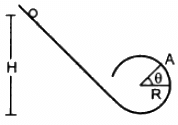
(a) Let the velocity and angular velocity of the ball at point A be v and ω, respectively.
Total kinetic energy at point
Total potential energy at point
On applying the law of conservation of energy, we have
Total energy at initial point = Total energy at A
Therefore, we get
(b) Let us now find the acceleration components.
Radial acceleration,
For tangential acceleration,
Differentiating equation (2) w.r.t. 't',
(c) At θ = 0, from the free body diagram, we have
Normal force = N = mar
At θ = 0, from the free body diagram, we get
Q.80. A thin spherical shell of radius R lying on a rough horizontal surface is hit sharply and horizontally by a cue. Where should it be hit so that the shell does not slip on the surface?
If the shell does not slip on the surface, its motion should be pure rolling.
Let the cue hits at a height 'h' above the centre.
Let the centre of shell moves with velocity vc and shell rotates with angular velocity ω after hitting.
For pure rolling,
vc = Rω
On applying the law of conservation of angular momentum at point O, we get
Q.81. A uniform wheel of radius R is set into rotation about its axis at an angular speed ω. This rotating wheel is now placed on a rough horizontal surface with its axis horizontal. Because of friction at the contact, the wheel accelerates forward and its rotation decelerates till the wheel starts pure rolling on the surface. Find the linear speed of the wheel after it starts pure rolling.
Initial angular momentum,
Angular momentum after it starts pure rolling,
As no external torque is applied, angular momentum will be conserved.
Therefore, we have
Q.82. A thin spherical shell lying on a rough horizontal surface is hits by a cue in such a way that the line of action passes through the centre of the shell. As a result, the shell starts moving with a linear speed v without any initial angular velocity. Find the linear speed of the shell after it starts pure rolling on the surface.
Initial angular momentum about point A,
L = mvR
Angular momentum about point A' after it starts pure rolling,
As no external torque is applied, angular momentum will be conserved.
Therefore, we have
Q.83. A hollow sphere of radius R lies on a smooth horizontal surface. It is pulled by a horizontal force acting tangentially from the highest point. Find the distance travelled by the sphere during the time it makes one full rotation.
Let M be the mass of the hollow sphere and α be the angular acceleration produced in the sphere by the tangential force F.
Torque due to this force,
Let d be the distance travelled in this time t.
Acceleration,
Q.84. A solid sphere of mass 0⋅50 kg is kept on a horizontal surface. The coefficient of static friction between the surfaces in contact is 2/7. What maximum force can be applied at the highest point in the horizontal direction so that the sphere does not slip on the surface?
Let α be the angular acceleration produced in the sphere.
Rotational equation of motion,
Translational equation of motion,
For pure rolling, we have
Putting the value of α in equation (1), we get
Q.85. A solid sphere is set into motion on a rough horizontal surface with a linear speed ν in the forward direction and an angular speed ν/R in the anticlockwise directions as shown in the following figure. Find the linear speed of the sphere (a) when it stops rotating and (b) when slipping finally ceases and pure rolling starts.
(a)
Initial angular momentum about point A,
Angular momentum about point A' after it stops rotating,
As no external torque is applied, angular momentum will be conserved.
Therefore, we have
(b)
Angular momentum about point A after it stops rotating,
Angular momentum about point A' after it starts pure rolling.
As no external torque is applied, angular momentum will be conserved.
Therefore, we have
Q.86. A solid sphere rolling on a rough horizontal surface with a linear speed ν collides elastically with a fixed, smooth, vertical wall. Find the speed of the sphere after it has started pure rolling in the backward direction.
Consider two cases:-
(a) Just after the collision with the wall, the sphere rebounds with velocity v towards left but it continues to rotate in the clockwise direction (as shown in figure)
Angular momentum of the sphere about centre,
(b) When pure rolling starts
Let the velocity be v' and the corresponding angular velocity be v'/R.
Angular momentum is constant.
Therefore, we have
L = L'
So, the sphere will move with velocity 3v/7.
|
134 docs
|


